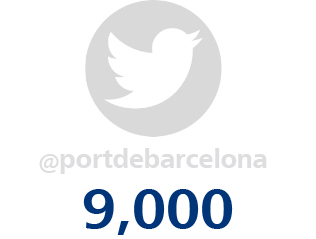In 2017 the Port performed a great many actions to publicise messages in the media; putting across its commitment to innovation, efficiency, sustainability and responding to institutional visits.
Institutional relations and communication
In 2017 the various areas making up the Department of Institutional Relations and Communication performed a great many actions to publicise the messages of the Port of Barcelona in the media; to transmit its commitment to innovation, efficiency and sustainability, and to respond to the visits - mainly institutional and commercial - made in the Port. External communications are the main task of the Press Office and the Image Area, while the Public Relations area is responsible for organising visits and events of all kinds promoted by the Port of Barcelona.
In 2017 the Communication Department continued to develop a strategy based on transparency, rigour of information and expanding its own digital media.
The media continue to be the main mouthpiece of the Port, although the channels open on social networks are gaining more and more importance. Other means of communication are also important, such as brochures and videos produced and published throughout the year on specific traffic and services, as well as on issues of public interest such as the environment, cruises, the Quality Label, etc.
The Port’s presence on the social networks - Twitter, Linkedin, YouTube, Google and Flickr - continued to grow throughout 2017, with particular emphasis on the Twitter account @portdebarcelona, which now has around 9,000 followers.
 Followers
Followers
2017 was a record year for almost all traffic segments (61 million tonnes and 3 million TEU), with figures bringing the Port closer to the goals set in its Third Strategic Plan 2015- 2020. The Communication Department has brought these results to the fore, while at the same time giving specific attention to the messages that underlie its main aims: growth, competitiveness and sustainability. The Port has made it particularly clear that this growth in traffic is the result of several factors: the activity in the hinterland that it serves; the commitment to Barcelona by shipping companies around the world, which has helped to bring about the increase in traffic in all traffic segments (import, export and transit), and the Port Community’s orientation to Customer needs, among others.
As a complement to the excellent traffic results, the Port of Barcelona was present at the main maritime transport and international trade fairs, conferences and international events. All these commercial and dissemination actions were provided specific support from the various areas of the Institutional Relations and Communication Department, both in the design and production of stands and specific materials for each fair provided by the Image Area and the media tracking performed before, during and after each event.
The participation at various fairs, events and seminars dedicated to the transport and logistics of fresh products, such as Fruit Logística, Medfel or Fruit Attraction, or the Canal Frío railway service with Zaragoza are notable examples of this. Widespread coverage was given to initiatives to promote the Port in its markets in the Iberian Peninsula and North Africa. The Maghreb and the Mediterranean coast hosted various initiatives by the Port in training, promotion and collaboration in the logistics, maritime and commercial fields, which was the case of the Hispano-Moroccan Meetings.
Initiatives aimed at guaranteeing the sustainability of port activity were also a key focus of communication efforts. The department reflected the advances made in the various projects included in the Port of Barcelona Air Quality Improvement Plan: the electric connection to a boat from a liquefied natural gas (LNG) engine; adapting two straddle carriers to run on LNG; adapting a barge to supply LNG to vessels, designing a tugboat driven by LNG and adapting 26 heavy trucks to run on this fuel, among other projects, were regularly explained to the Port Community and to society at large.
Likewise, the Port’s efforts to promote the use of electric vehicles has been widely publicised, commissioning a fleet of its own vehicles and setting up various public recharging points to encourage companies to gradually replace their current vehicles with electrical units.
Innovation as a factor of competitiveness in the transport and logistics sector is another pillar on which the Port’s growth is based. Two examples of this are the Port Innova- Barcelona Port Hackathon, which aims to promote the culture of innovation by connecting the educational world with the port’s business fabric and its real issues; and the Port’s acceleration programme, named Port Challenge Barcelona, which aims to promote the creation of technology-based companies that help improve the efficiency and competitiveness of the port logistics community.
At the international level, the Port has publicised the presence of its leaders at fairs and conferences in our main markets, China and the whole of the Asian continent, Latin America and North Africa. Also the holding, in Barcelona, of events such as the Chain Port Academy, organised by the international network of smart ports, the International Association of Port Telematic Platforms and the committee meetings of the IAPH - of which the Port holds the presidency - have made it possible to inform audiences around the world of the work carried out by the Port of Barcelona to consolidate its position as the southern gateway to Europe and the main logistics platform of the Mediterranean.